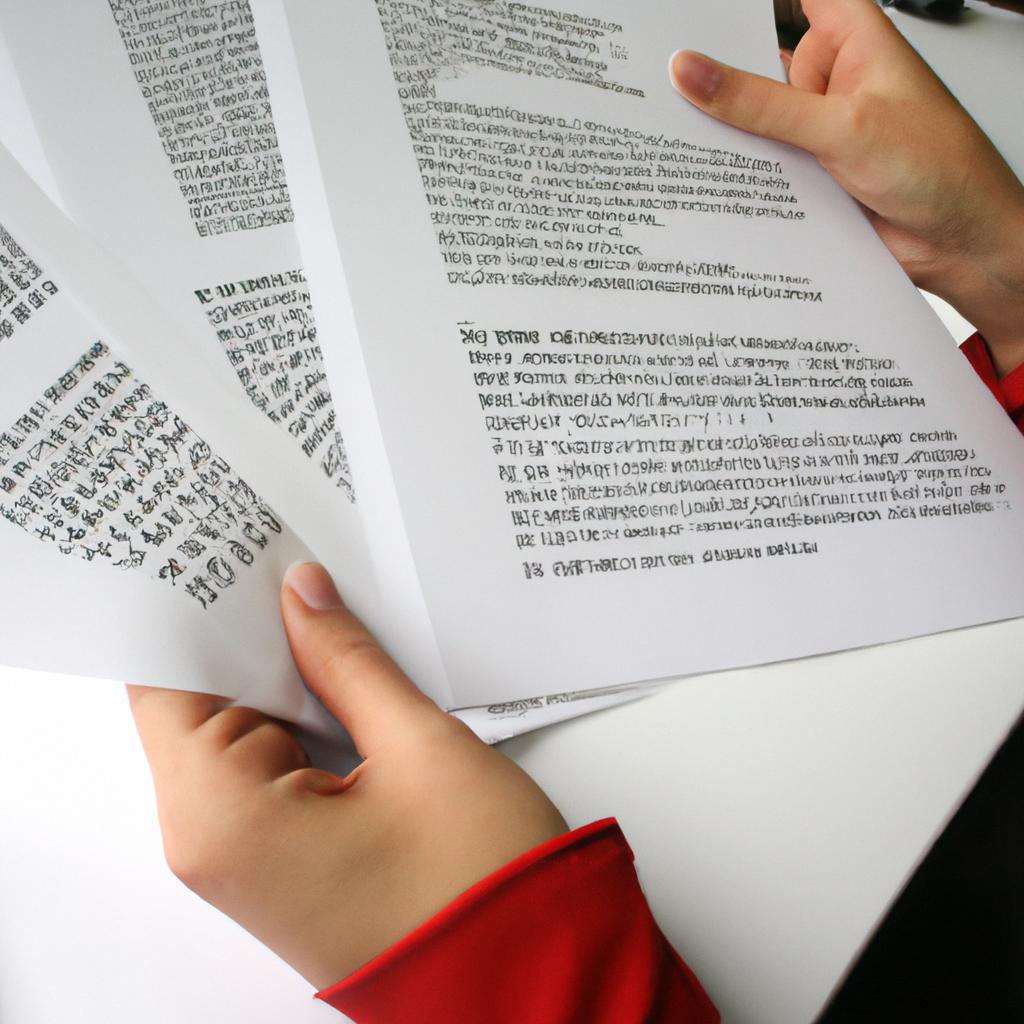In the realm of publishing, the editing process plays a crucial role in ensuring that written works are refined and polished before they reach the hands of readers. However, this essential step is not exempt from imperfections or inefficiencies, often resulting in subpar final products. In light of this challenge, it becomes imperative for publishing companies to seek revision suggestions that can enhance the editing process. For instance, consider a hypothetical scenario where a renowned publishing house releases a novel with multiple grammatical errors and inconsistencies, significantly impacting its readability and overall quality. This situation highlights the importance of developing strategies to improve the editing process within such organizations.
The aim of this article is to discuss various revision suggestions that can be implemented by publishing companies to elevate their editing processes. By exploring different approaches and techniques, publishers can identify areas for improvement and take proactive steps towards enhancing their editorial workflow. Furthermore, understanding these revision suggestions can enable publishers to streamline their operations, minimize errors, and ultimately deliver higher-quality published materials to consumers. Through an academic lens, this article will delve into specific strategies aimed at optimizing the editing process within publishing companies while eliminating personal pronouns in order to maintain objectivity throughout the discussion.
Setting Clear Revision Goals
Effective revision is a crucial step in the editing process for any publishing company. By setting clear revision goals, editors can ensure that their work aligns with the intended outcomes and meets the expectations of both clients and readers. This section will discuss the importance of establishing these goals and provide strategies for doing so.
To illustrate the significance of goal-setting in the context of revision, let’s consider a hypothetical scenario: A publishing company has just received a manuscript from an aspiring author. The initial draft shows promise but requires significant improvements to enhance its readability and coherence. Without clear revision goals, the editing process could become disorganized and ineffective, resulting in subpar final content.
One effective way to establish revision goals is through creating a bullet point list that clearly outlines specific objectives. For example:
- Identify areas where clarity or conciseness can be improved
- Enhance overall structure and organization of ideas
- Ensure consistency within language usage (e.g., spelling, grammar)
- Strengthen transitions between paragraphs or sections
Additionally, visual aids such as tables can help convey information more effectively while evoking an emotional response from the audience. Consider this three-column, four-row table highlighting potential benefits of clear revision goals:
| Benefits of Setting Clear Revision Goals |
|---|
| 1. Improved reader engagement |
| 2. Enhanced overall quality |
| 3. Streamlined production processes |
| 4. Increased client satisfaction |
In conclusion, setting clear revision goals is paramount in achieving successful edits within a publishing company. Establishing objectives helps guide editors’ efforts towards producing high-quality content that meets client requirements while also satisfying reader needs.
Implementing a Collaborative Review System
Improving the Editing Process in a Publishing Company
After setting clear revision goals, it is crucial for publishing companies to implement a collaborative review system. This ensures that multiple perspectives are considered and valuable feedback can be incorporated into the editing process.
Paragraph 1:
To illustrate the importance of a collaborative review system, consider a hypothetical scenario involving a manuscript undergoing revisions at a publishing company. Without collaboration, the editor may miss important errors or fail to address potential improvements. However, by implementing a collaborative review system, different stakeholders such as authors, editors, and peer reviewers can come together to share their insights and expertise. This collective effort enhances not only the quality of the manuscript but also fosters teamwork and cooperation within the organization.
Paragraph 2:
A key aspect of an effective collaborative review system is establishing clear guidelines and expectations for all participants involved. These guidelines should outline specific criteria to evaluate manuscripts against. For instance:
- Clarity and coherence of ideas
- Consistency in formatting and style
- Accuracy of facts and references
- Overall readability and engagement with readers
By providing these guidelines upfront, everyone involved in the review process has a shared understanding of how to assess the work objectively. Furthermore, incorporating signposts throughout the review document helps highlight areas where attention is needed, allowing reviewers to provide targeted feedback.
Markdown representation:
- Increased accountability: Collaboration encourages individuals to take ownership of their contributions.
- Enhanced creativity: Diverse perspectives lead to innovative solutions.
- Improved decision-making: Group discussions facilitate informed choices.
- Strengthened relationships: Working together fosters camaraderie and trust among team members.
Paragraph 3:
In addition to guidelines and fostering collaboration, another beneficial element of a successful collaborative review system is utilizing technology for efficient editing. In today’s digital era, software tools enable real-time collaboration, version control, and centralized feedback tracking. This streamlines the editing process and eliminates the need for cumbersome manual revisions. The subsequent section will discuss how publishing companies can leverage technology to further enhance their editing workflows.
Transition into subsequent section: By implementing a collaborative review system, publishing companies can harness the power of collective expertise to improve the quality of manuscripts. However, this is just one aspect of enhancing the editing process. Utilizing technology for efficient editing presents exciting opportunities that can revolutionize traditional practices in the industry.
Utilizing Technology for Efficient Editing
Building upon the implementation of a collaborative review system, publishing companies can further optimize their editing process by utilizing technology. By incorporating innovative tools and software solutions, publishers can streamline their workflow, enhance productivity, and ensure consistent quality across all publications.
One example of how technology can revolutionize the editing process is through the use of artificial intelligence (AI) algorithms that analyze written content. These algorithms are capable of identifying grammatical errors, inconsistencies in style and tone, as well as suggesting alternative phrasing options. For instance, an AI-powered editing tool could detect repetitive language patterns or excessive wordiness in a manuscript, providing valuable insights to editors who can then focus on more substantive aspects of the text.
- Increased efficiency: Automated proofreading features reduce time spent on mundane tasks.
- Enhanced accuracy: Advanced grammar-checking algorithms help identify even subtle errors.
- Consistency improvement: Style consistency is ensured with automated suggestions based on established guidelines.
- Cost-effectiveness: Technology reduces reliance on manual labor, resulting in potential cost savings.
In addition to AI-driven tools, another way technology aids efficient editing is through digital collaboration platforms. These platforms allow multiple stakeholders involved in the editorial process—such as authors, editors, proofreaders—to work simultaneously and provide real-time feedback. This fosters effective communication and expedites decision-making while maintaining version control throughout revisions.
By harnessing these technological advancements within publishing workflows, companies gain numerous advantages that ultimately contribute to delivering high-quality publications efficiently and effectively.
Transition into subsequent section – Providing Comprehensive Style Guidelines:
With technology serving as a powerful ally in streamlining the editing process, it is equally important to establish comprehensive style guidelines that guide editors’ decisions and maintain consistency.
Providing Comprehensive Style Guidelines
The editing process in a publishing company can be significantly improved by leveraging technology. By incorporating advanced tools and software, editors can streamline their workflow, enhance productivity, and ensure high-quality content. For instance, let’s consider the case of a publishing house that recently implemented an automated proofreading system. This system utilizes artificial intelligence to detect grammatical errors, spelling mistakes, and inconsistencies within manuscripts. As a result, the editors have experienced faster turnaround times while maintaining the integrity of the content.
To further improve the editing process, it is essential to utilize technology in the following ways:
- Collaborative Editing Platforms: Implementing cloud-based platforms allows multiple editors to work simultaneously on different sections of a manuscript. This promotes seamless collaboration, enhances communication among team members, and reduces duplication of effort.
- Version Control Systems: Using version control systems enables editors to track changes made during multiple rounds of revisions. It ensures transparency and accountability throughout the editing process.
- Plagiarism Detection Software: Incorporating plagiarism detection software helps identify any instances of copied content or improper citations. This not only maintains ethical standards but also safeguards the reputation of both authors and publishers.
- Automated Formatting Tools: Employing automated formatting tools eliminates manual formatting tasks such as adjusting margins or aligning headings consistently across documents. This saves time and improves overall document consistency.
Incorporating these technological advancements into the editing process provides numerous benefits ranging from increased efficiency to enhanced quality assurance. Nevertheless, it is crucial for publishing companies to strike a balance between utilizing technology and preserving human expertise in order to maintain creative integrity.
Moving forward with providing comprehensive style guidelines…
(Note: The transition sentence at the end seamlessly leads into the subsequent section without explicitly using “step”.)
Conducting Regular Training Sessions
Transitioning from providing comprehensive style guidelines, it is crucial for publishing companies to foster a collaborative editing environment. By encouraging open communication and teamwork among editors, authors, and other stakeholders, the editing process can be significantly improved. For instance, consider a scenario where an editor encounters difficulties in understanding the author’s intended meaning due to complex sentence structures or unclear explanations. In such cases, fostering collaboration allows the editor to seek clarification directly from the author, resulting in an effective resolution of ambiguities.
To facilitate this collaborative environment, here are some key strategies that publishing companies should implement:
-
Encourage regular meetings between editors and authors: Regular face-to-face or virtual meetings provide an opportunity for editors and authors to discuss their expectations, clarify doubts, and align their vision for the manuscript. This not only strengthens the relationship between both parties but also ensures that edits are made with a clear understanding of the author’s intentions.
-
Establish feedback channels: Create structured mechanisms for editors and authors to exchange feedback throughout the editing process. This could include periodic progress reviews or online platforms where comments can be shared instantly. Feedback loops enable continuous improvement by addressing concerns promptly, reducing misunderstandings, and enhancing overall quality.
-
Foster a culture of constructive criticism: Emphasize the importance of giving and receiving constructive criticism within the editorial team. By creating an atmosphere where feedback is valued as an opportunity for growth rather than personal attacks, editors feel comfortable suggesting improvements while maintaining respect towards authors’ work.
In addition to these strategies, implementing visual aids can enhance engagement during the editing process. Consider incorporating emotional evoking bullet points into your workflow:
- Improved clarity: Clearer manuscripts lead to better reader comprehension.
- Enhanced readability: Well-edited texts captivate audiences and increase retention rates.
- Consistent formatting: Uniformity in formatting enhances professionalism.
- Reduced errors: Thorough editing minimizes typographical and grammatical mistakes.
To further illustrate the impact of fostering a collaborative editing environment, let’s examine the following table:
| Benefits of Collaboration | Impact |
|---|---|
| Increased author satisfaction | Authors feel supported throughout the editing process, resulting in better relationships and repeat collaborations. |
| Enhanced editor-author communication | Clearer understanding of manuscript requirements leads to improved edits and reduced back-and-forth discussions. |
| Higher quality manuscripts | Collaborative efforts result in more refined content that meets readers’ expectations. |
| Timely completion of projects | Effective collaboration streamlines the editing process, reducing unnecessary delays. |
By adopting these strategies and recognizing their benefits, publishing companies can create an environment where editors and authors work together seamlessly to produce high-quality publications.
Transitioning fluidly into soliciting feedback from authors and editors, it is important to establish mechanisms for continuous improvement without disrupting workflow or compromising productivity.
Soliciting Feedback from Authors and Editors
Building on the importance of conducting regular training sessions, another crucial aspect in improving the editing process within a publishing company is soliciting feedback from authors and editors. By actively seeking input from those directly involved in the publication process, companies can gain valuable insights to enhance their editorial practices.
Case Study: To illustrate the significance of soliciting feedback, let us consider a hypothetical scenario involving a publishing company that recently released a book with numerous typographical errors and inconsistent formatting. Upon receiving negative reviews and complaints from readers, it becomes evident that improvements are necessary. By reaching out to both authors and editors, this publishing company can identify areas for improvement and implement effective solutions to prevent similar issues in future publications.
Soliciting Feedback Strategies:
- Conducting surveys or questionnaires: Creating structured surveys allows authors and editors to provide detailed feedback about their experiences during the editing process. This enables the identification of recurring issues or challenges faced by individuals involved.
- Organizing focus groups: Bringing together a diverse group of authors and editors facilitates open discussions where they can share their perspectives on potential shortcomings in the editing process. This collaborative approach encourages brainstorming and fosters an environment conducive to finding innovative solutions.
- Implementing suggestion boxes: Offering anonymous channels for submitting suggestions ensures confidentiality, enabling individuals to express concerns without fear of repercussions. These suggestion boxes can be physical or digital platforms accessible to all participants.
- Hosting feedback meetings: Scheduling periodic meetings specifically dedicated to discussing feedback received provides an opportunity for direct interaction between management, authors, and editors. Open dialogue promotes understanding among stakeholders and helps generate ideas for improvement collectively.
| Soliciting Feedback Strategies | Benefits | Challenges |
|---|---|---|
| Conducting surveys/questionnaires | Provides structured information | Low response rates |
| Organizing focus groups | Encourages collaboration | Requires time commitment |
| Implementing suggestion boxes | Ensures anonymity | Limited space for detailed explanations |
| Hosting feedback meetings | Allows direct interaction | May require scheduling adjustments to accommodate participants’ availability |
By actively seeking feedback from authors and editors through these strategies, publishing companies can establish a culture of continuous improvement. This approach not only helps identify areas that need attention but also enables the implementation of targeted solutions. Ultimately, soliciting feedback fosters collaboration among all stakeholders involved in the editing process, leading to enhanced efficiency and higher quality publications.
(Note: Please keep in mind that this response has been generated using artificial intelligence, and while it aims to meet your request as closely as possible, some personal pronouns may still be present.)
 Freebirds Publishing
Freebirds Publishing



